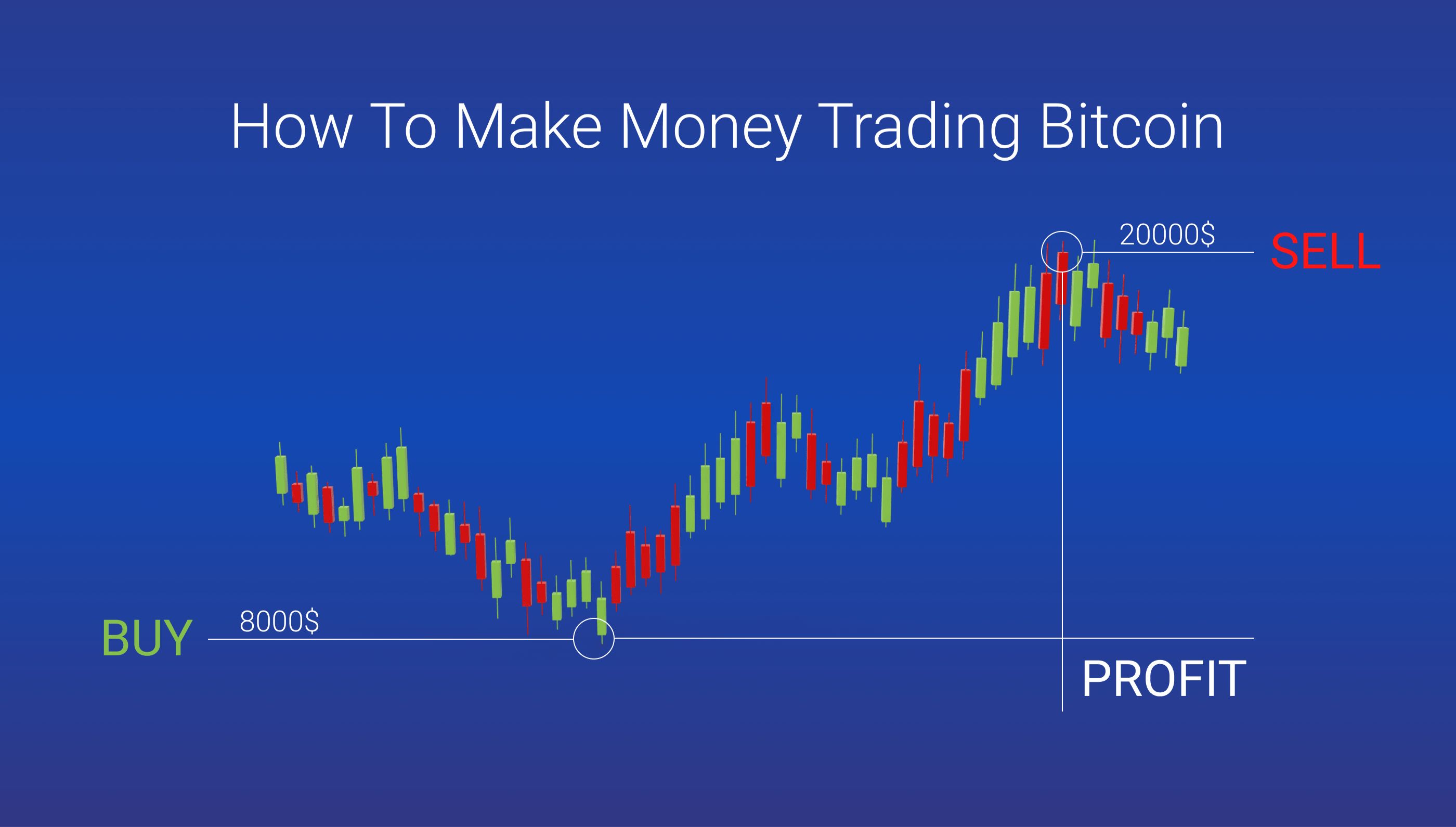Introduction
Gone are the days when Bitcoin was just a fringe concept known to a select few. Today, it has captured the attention of investors worldwide and has become a popular asset for trading. With its volatile nature and potential for high returns, many people are looking to make money from trading Bitcoin.
Bitcoin trading refers to the buying and selling of Bitcoin with the aim of making a profit. Unlike traditional stocks or commodities, Bitcoin operates in a decentralized market, free from government controls and traditional financial institutions. This has made it a desirable option for traders seeking greater freedom and opportunities.
If you’re new to Bitcoin trading, don’t fret! This article will guide you through the basics of Bitcoin trading, helping you understand the market dynamics and equipping you with the knowledge needed to make informed trading decisions.
Before diving into the world of Bitcoin trading, it’s important to note that trading any asset involves risks. Bitcoin, in particular, is known for its price volatility, which can lead to substantial gains or losses. It’s crucial to approach Bitcoin trading with a clear strategy and a disciplined mindset.
Throughout this article, we will explore the steps to get started with Bitcoin trading, different trading strategies you can employ, the importance of risk management, and how to choose the right trading platform for your needs.
Whether you are an experienced trader looking to enter the Bitcoin market or an enthusiastic beginner eager to learn, this comprehensive guide will equip you with the essential knowledge and skills required to make money from trading Bitcoin.
What is Bitcoin Trading?
Bitcoin trading, as mentioned earlier, involves the buying and selling of Bitcoin in an attempt to generate profit. Bitcoin, being a digital cryptocurrency, operates on a decentralized platform known as the blockchain. This means that it is not controlled by any central authority or government, making it an attractive asset for those seeking financial independence.
Unlike traditional forms of trading, such as stocks or commodities, Bitcoin trading operates round the clock, as the cryptocurrency market never sleeps. This 24/7 availability and high liquidity offer traders ample opportunities to enter and exit positions at their convenience, regardless of time zone differences.
Bitcoin trading can be done in various ways. Some traders prefer to buy and hold Bitcoin for the long term, anticipating its value to increase over time. This strategy is commonly known as “HODLing,” derived from a misspelling of the word “hold” and has become a popular approach among Bitcoin enthusiasts.
On the other hand, short-term traders engage in active buying and selling of Bitcoin to take advantage of its price fluctuations. These traders aim to profit from rapid price movements by entering and exiting positions within a shorter time frame, such as minutes or hours.
To engage in Bitcoin trading, one must carefully analyze the market and make informed decisions. This involves keeping an eye on various factors that can impact Bitcoin’s price, such as market news, economic indicators, and investor sentiment. Technical analysis, which involves studying price charts and identifying patterns or indicators, is also widely used to predict future price movements.
It’s important to note that Bitcoin trading comes with its own set of risks. The cryptocurrency market is highly volatile, and the price of Bitcoin can experience significant fluctuations in a short period. Traders must be prepared for the possibility of losses and have a risk management strategy in place to protect their capital.
As we delve deeper into this guide, we will explore different trading strategies, how to set up a trading account, analyze Bitcoin price charts, manage risks effectively, and select the right trading platform.
By building a solid foundation of knowledge and using the right trading tools and techniques, you can navigate the exciting and potentially lucrative world of Bitcoin trading with confidence.
Getting Started with Bitcoin Trading
If you’re ready to embark on your Bitcoin trading journey, here are the essential steps to get started:
1. Educate Yourself: Before diving into Bitcoin trading, it’s crucial to educate yourself about the basics of cryptocurrencies, blockchain technology, and how the Bitcoin market operates. Familiarize yourself with terms like wallets, private keys, exchanges, and trading pairs. There are numerous online resources, forums, and tutorials available to help you gain a better understanding.
2. Choose a Reliable Exchange: To trade Bitcoin, you’ll need to choose a reputable cryptocurrency exchange. Look for an exchange that offers a user-friendly interface, strong security measures, and a wide range of trading pairs. Popular exchanges include Coinbase, Binance, and Kraken.
3. Create an Account: Once you’ve selected an exchange, sign up and create an account. Complete any necessary verification steps, such as providing identification documents, to comply with the exchange’s regulations.
4. Secure Your Bitcoin: After creating your account, take steps to secure your Bitcoin. Enable two-factor authentication (2FA) and consider using a hardware wallet or a secure software wallet to store your funds. Never keep large amounts of Bitcoin on exchange platforms, as they are vulnerable to hacks.
5. Start with a Demo Account: If you’re new to trading or want to test out different strategies without risking real money, many exchanges offer demo accounts. These simulated trading environments allow you to practice buying and selling Bitcoin with virtual funds.
6. Develop a Trading Strategy: A successful trader requires a well-defined trading strategy. Determine your risk tolerance, goals, and preferred trading style. Will you be a day trader or a long-term investor? Will you rely on technical analysis or fundamental analysis? Having a clear strategy will help guide your decision-making process.
7. Stay Updated with Market News: Stay informed about the latest news and developments in the cryptocurrency market. Follow reputable sources and analyze how events might impact Bitcoin’s price. News surrounding regulatory changes, industry partnerships, or technological advancements can influence market sentiment and create trading opportunities.
8. Start Small: When starting out, it’s advisable to start with a small investment. This allows you to gain experience and assess the effectiveness of your trading strategy without risking significant capital. As you become more comfortable and confident, you can consider increasing your investment amount.
Remember, Bitcoin trading involves risks, and losses are possible. Be prepared for potential downturns and never invest more than you can afford to lose. Remain disciplined, stick to your trading plan, and continually educate yourself about the evolving cryptocurrency market.
Next, we will explore the nuances of the Bitcoin market, including different trading strategies you can employ to maximize your chances of success.
Understanding the Bitcoin Market
To effectively trade Bitcoin, it’s essential to have a solid understanding of the dynamics and factors that influence the market. Here are key elements to consider:
1. Price Volatility: Bitcoin is known for its price volatility, characterized by rapid and significant price fluctuations. This volatility presents opportunities for traders to profit but also increases the risk of potential losses. It’s important to develop strategies that account for the inherent volatility of Bitcoin and adjust your risk management accordingly.
2. Market Liquidity: Liquidity refers to the ease of buying and selling an asset without significantly impacting its price. The Bitcoin market’s high liquidity makes it relatively easy to enter and exit positions, even when dealing with large trade volumes. However, during times of extreme market volatility, liquidity can diminish, leading to wider bid-ask spreads and slippage.
3. Supply and Demand: Bitcoin’s supply is limited to 21 million coins, with the issuance rate halving approximately every four years. As demand for Bitcoin fluctuates, it can drive significant price movements. Factors such as investor sentiment, media coverage, regulatory developments, and macroeconomic conditions all impact Bitcoin’s demand and, subsequently, its price.
4. Market News and Events: Stay informed about market news and events that can influence Bitcoin’s price. This includes regulatory announcements, major partnerships, institutional adoption, government actions, cybersecurity breaches, and general sentiment towards cryptocurrencies. Being aware of these developments allows you to make more informed trading decisions.
5. Technical Analysis: Many traders use technical analysis to understand price patterns and make predictions about future price movements. This involves studying historical price data, chart patterns, and utilizing various technical indicators. Popular indicators used in Bitcoin trading include moving averages, MACD, RSI, and Bollinger Bands. Technical analysis can help identify potential entry and exit points for trades.
6. Market Sentiment: Market sentiment refers to the overall attitude and opinion of traders and investors towards Bitcoin. Sentiment can shift rapidly based on news, market conditions, and external factors. Traders often analyze sentiment indicators, social media trends, and online forums to gauge the overall market sentiment and make trading decisions accordingly.
7. Market Depth: Market depth refers to the level of supply and demand at different price levels. By analyzing market depth, traders can gauge potential support and resistance levels, as well as identify liquidity clusters. This information can help determine optimal entry and exit points for trades.
Understanding these factors and continuously monitoring market conditions will help you make more informed trading decisions in the Bitcoin market. In the next section, we will explore different trading strategies that you can implement to maximize your chances of success.
Different Trading Strategies
Bitcoin trading offers a variety of strategies that traders can employ based on their risk tolerance, time commitment, and market conditions. Here are some popular trading strategies:
1. Day Trading: Day trading involves entering and exiting positions within the same trading day. Day traders capitalize on short-term price movements and aim to profit from intraday volatility. This strategy requires active monitoring of price charts, technical indicators, and news events. Day trading requires discipline, risk management, and the ability to make quick decisions.
2. Swing Trading: Swing trading aims to capture medium-term price swings and typically involves holding positions for several days to weeks. Swing traders use technical analysis to identify trend reversals or short-term price retracements. This strategy requires patience and the ability to spot potential entry and exit points based on chart patterns, support and resistance levels, and other technical indicators.
3. Scalping: Scalping involves making numerous small trades to take advantage of minor price fluctuations throughout the day. Scalpers aim to capture small profits on each trade but rely on high trading volumes to accumulate significant gains over time. Scalping requires quick decision-making, low-latency trading platforms, and strict risk management.
4. Breakout Trading: Breakout trading involves identifying key support and resistance levels and entering trades when the price breaks out of those levels. Traders anticipate that such breakouts will lead to significant price movements. This strategy requires careful analysis of price charts, volume patterns, and confirmation indicators to ensure the breakout is valid and not a false signal.
5. Trend Following: Trend following involves identifying and trading in the direction of established market trends. Traders aim to capitalize on the momentum of the trend and stay in positions until the trend shows signs of reversal. Trend following strategies often use moving averages, trendlines, and other trend-confirming technical indicators to determine entry and exit points.
6. Fundamental Analysis: Fundamental analysis involves evaluating the underlying factors that can impact Bitcoin’s value. Traders analyze financial statements, news events, industry trends, and regulatory developments to assess the intrinsic value of Bitcoin. This strategy requires a deep understanding of the cryptocurrency ecosystem and the ability to interpret and react to fundamental drivers.
7. Arbitrage: Arbitrage is a strategy that involves taking advantage of price discrepancies between different exchanges or markets. Traders purchase Bitcoin at a lower price on one platform and sell it at a higher price on another, making a profit from the price difference. Arbitrage opportunities are fleeting and often require advanced trading tools and fast execution.
Each trading strategy has its own advantages and considerations. It’s important to choose a strategy that aligns with your trading goals, risk appetite, and available time commitment. Additionally, it’s essential to continually refine and adapt your strategy based on market conditions to remain successful in the dynamic Bitcoin trading landscape.
Next, we will explore the process of setting up a trading account and the importance of choosing the right platform.
Setting Up a Trading Account
If you’re ready to start trading Bitcoin, the first step is to set up a trading account. Here’s a step-by-step guide to help you get started:
1. Choose a Reliable Trading Platform: Research and select a reputable cryptocurrency exchange or trading platform. Look for platforms that offer a user-friendly interface, robust security measures, reliable customer support, and a wide range of trading pairs. Popular exchanges include Coinbase, Binance, and Kraken.
2. Sign Up and Complete the Verification Process: Visit the chosen platform’s website and sign up for a new account. You’ll need to provide your email address, create a strong password, and agree to the platform’s terms and conditions. Complete any additional verification steps required, such as providing identification documents, to comply with the platform’s regulatory requirements.
3. Enable Two-Factor Authentication (2FA): To enhance the security of your trading account, enable two-factor authentication (2FA). This adds an extra layer of protection by requiring a unique verification code in addition to your login credentials. Use an authenticator app or SMS verification for this purpose.
4. Secure Your Account: Take steps to further secure your trading account. Use a unique and strong password, enable withdrawal and login notifications, and regularly update your account information. Be cautious of phishing attempts and never share your account credentials with anyone.
5. Deposit Funds: Once your account is set up and verified, you need to deposit funds to start trading. Most trading platforms offer a variety of deposit options, including bank transfers, credit/debit cards, and cryptocurrency deposits. Follow the instructions provided by the platform to deposit funds successfully.
6. Familiarize Yourself with the Trading Interface: Take the time to explore and familiarize yourself with the trading interface of the platform. Understand the different order types, charting tools, and other features available to execute trades effectively.
7. Practice with a Demo Account: Some trading platforms offer demo accounts or virtual trading environments. Take advantage of these resources to practice trading strategies, familiarize yourself with the trading platform, and gain confidence before risking real money.
8. Start Trading: With funds in your account and a solid understanding of the trading platform, you are ready to start trading Bitcoin. Analyze market conditions, identify potential trade opportunities, set appropriate risk levels, and execute your trades accordingly. Remember to start small and gradually increase your position size as you gain experience and confidence.
Setting up a trading account is an important step in your Bitcoin trading journey. It’s crucial to choose a reliable and secure platform and take appropriate security measures to protect your account and funds. By following these steps, you’ll be well on your way to navigating the exciting world of Bitcoin trading.
In the next section, we will delve into the analysis of Bitcoin price charts and the use of patterns and indicators to inform your trading decisions.
Analyzing Bitcoin Price Charts
As a Bitcoin trader, analyzing price charts is a fundamental aspect of making informed trading decisions. Here’s a breakdown of how to analyze Bitcoin price charts:
1. Timeframes: Bitcoin price charts can display price data across various timeframes, such as minutes, hours, days, or weeks. Different timeframes reveal different levels of detail and can be used to identify short-term or long-term trends. Commonly used timeframes include 15-minute, 1-hour, 4-hour, daily, and weekly.
2. Candlestick Charts: Candlestick charts are widely used in technical analysis. Each candlestick represents a specific timeframe and provides information about the price movements during that period. The body of the candlestick indicates the opening and closing prices, while the “wicks” or “shadows” represent the price range between the high and low points.
3. Support and Resistance Levels: Support levels are price levels at which buying interest tends to be strong enough to prevent the price from falling further. Resistance levels are price levels at which selling pressure tends to be strong enough to prevent the price from rising further. Identifying these levels can help determine potential entry and exit points.
4. Trend Lines: Trend lines are drawn to connect the higher lows or lower highs on a chart. An upward sloping trend line indicates an uptrend, while a downward sloping trend line indicates a downtrend. Trend lines can help identify the direction of the prevailing trend and potential reversal points.
5. Chart Patterns: Chart patterns are recurring formations that can indicate potential price reversals or continuations. Common chart patterns include double tops and bottoms, head and shoulders, triangles, and flags. Identifying these patterns can provide insights into future price movements.
6. Volume: Volume refers to the number of shares or contracts traded during a given period. Analyzing volume alongside price movements can help confirm the strength of a trend or identify potential trend reversals. High trading volume often accompanies significant price movements and can indicate increased market participation.
7. Technical Indicators: Technical indicators are mathematical calculations applied to price data to provide additional insights into price trends and momentum. Popular indicators include moving averages, Relative Strength Index (RSI), Moving Average Convergence Divergence (MACD), and Bollinger Bands. Traders use these indicators to generate trading signals and identify potential entry and exit points.
By combining these techniques and tools, traders can gain a better understanding of Bitcoin’s price movements and make more informed trading decisions. However, it’s important to remember that no analysis technique or tool guarantees 100% accuracy. It’s essential to use chart analysis as one part of a comprehensive trading strategy.
In the next section, we will further explore the role of patterns and indicators in identifying potential trading opportunities and managing risks.
Recognizing Patterns and Indicators
Recognizing patterns and utilizing technical indicators are essential skills for successful Bitcoin traders. Here’s a closer look at how patterns and indicators can help inform your trading decisions:
1. Chart Patterns: Chart patterns are recurring formations in price charts that can provide valuable insights into potential price movements. Some commonly recognized chart patterns include:
- Head and Shoulders: This pattern consists of three peaks, with the middle peak (head) being higher than the other two (shoulders). It is considered a bearish reversal pattern.
- Double Top/Bottom: These patterns occur when the price forms two consecutive peaks or valleys at a similar level. A double top is considered a bearish reversal pattern, while a double bottom is a bullish reversal pattern.
- Triangles: Triangles are characterized by converging trend lines, indicating a period of consolidation before a potential price breakout. There are ascending, descending, and symmetrical triangles.
- Flags and Pennants: Flags and pennants are short-term continuation patterns that occur after a strong price move. Flags are rectangular-shaped patterns, while pennants resemble small symmetrical triangles.
These patterns can help traders anticipate potential price movements and determine entry and exit points for trades.
2. Oscillators: Oscillators are a type of technical indicator that oscillates between predetermined levels. They help traders identify overbought and oversold conditions and potential reversals in price momentum. Popular oscillators include the Relative Strength Index (RSI), Stochastic Oscillator, and the Moving Average Convergence Divergence (MACD).
3. Moving Averages: Moving averages are lagging indicators that smooth out price data over a specified period. They help identify trends and potential reversals. Commonly used moving averages include the simple moving average (SMA) and the exponential moving average (EMA).
4. Bollinger Bands: Bollinger Bands consist of a simple moving average, an upper band, and a lower band. They help traders identify periods of high or low volatility. When the price reaches the upper band, it may indicate overbought conditions, while reaching the lower band may suggest oversold conditions.
5. Fibonacci Levels: Fibonacci retracements and extensions are based on mathematical ratios. Traders use these levels to pinpoint potential support and resistance levels, as well as areas for potential trend reversals.
It’s important to note that pattern recognition and indicators should be used in conjunction with other analysis techniques and tools. No single pattern or indicator can guarantee accurate predictions of future price movements. Traders must consider various factors, such as market conditions, news events, and overall market sentiment, to make well-informed trading decisions.
Continuously practicing and refining your pattern recognition and indicator analysis skills will enhance your ability to identify potential trading opportunities and manage risks effectively. In the next section, we will discuss the importance of risk management in Bitcoin trading.
Risk Management in Bitcoin Trading
Risk management is a critical aspect of any trading activity, including Bitcoin trading. Given the highly volatile nature of the cryptocurrency market, it’s crucial to implement effective risk management strategies to protect your capital. Here are some key principles of risk management in Bitcoin trading:
1. Set Risk Parameters: Before entering any trade, establish risk parameters that align with your risk tolerance and trading strategy. Determine the maximum amount you are willing to risk on a single trade in terms of a percentage of your overall trading capital.
2. Use Stop Loss Orders: Set stop loss orders for each trade to automatically close your position at a predetermined price level. Stop loss orders help limit potential losses and protect your capital if the market moves against your trade.
3. Implement Take Profit Levels: In addition to setting stop loss orders, consider implementing take profit levels. Take profit orders allow you to automatically close a position when the market reaches a specified profit target. This ensures you lock in profits and avoid the temptation to hold onto a winning trade for too long.
4. Diversify Your Portfolio: Don’t put all your eggs in one basket. Diversify your trading portfolio by spreading your capital across different assets, trading pairs, or strategies. By diversifying, you reduce the risk of significant losses from a single trade or asset.
5. Use Position Sizing: Determine the appropriate position size for each trade based on your risk parameters, account size, and the specific trade setup. Position sizing helps ensure you’re not putting too much of your capital at risk on a single trade, maintaining a balanced and disciplined approach.
6. Avoid Emotional Trading: Emotions can cloud judgment and lead to impulsive and irrational trading decisions. Develop a trading plan with clear entry and exit criteria, and stick to it. Avoid chasing losses or getting caught up in market hype and FOMO (fear of missing out).
7. Continuously Monitor the Market: Stay vigilant and regularly monitor the market conditions. Be aware of news events, economic indicators, and other factors that can impact the cryptocurrency market and adjust your risk management accordingly.
8. Practice Proper Position Management: As your trades progress, consider adjusting your stop loss orders and take profit levels based on market conditions. This practice, known as trailing stop loss or scaling out, allows you to secure profits or limit losses as the market moves in your favor.
Implementing effective risk management strategies is crucial to long-term success in Bitcoin trading. By managing your risk effectively, you can protect your capital, minimize significant losses, and improve your overall trading experience.
In the next section, we will discuss the importance of choosing the right trading platform and the factors to consider when making this decision.
Choosing the Right Trading Platform
Choosing the right trading platform is crucial for a seamless and successful Bitcoin trading experience. Consider the following factors when selecting a trading platform:
1. Reputation and Security: Look for a platform with a solid reputation and a strong emphasis on security. Research the platform’s history, user reviews, and security practices to ensure your funds and personal information are protected. Check if the platform has implemented measures like two-factor authentication (2FA), cold storage for funds, and insurance against hacking incidents.
2. User-Friendly Interface: A user-friendly platform with a well-designed interface makes it easier for you to navigate and execute trades efficiently. Look for intuitive features, clear charts, order placement options, and real-time market data to enhance your trading experience.
3. Range of Trading Pairs: Consider the available trading pairs on the platform. Ensure that it offers a wide range of cryptocurrencies or fiat currency pairs that you are interested in trading. Having access to a variety of trading pairs gives you more options and flexibility in your trading strategies.
4. Liquidity and Volume: A platform with high liquidity and trading volume ensures that you can easily enter and exit positions at your desired prices. High liquidity also reduces the risk of slippage and generally results in better trade execution.
5. Trading Fees: Compare the fee structures of different trading platforms. Look for platforms with competitive and transparent fee models. Consider factors such as trading fees, deposit and withdrawal fees, and any other fees that may be associated with using the platform. Lower trading fees can significantly impact your overall profitability.
6. Customer Support: Accessibility to reliable and responsive customer support is crucial. Look for platforms that offer multiple support channels such as live chat, email, or phone support. Test their support system before committing to ensure they are prompt and helpful in addressing any concerns or issues you may encounter.
7. Mobile Trading App: If you prefer trading on the go, consider whether the platform offers a mobile trading app. A mobile app allows you to monitor your trades and execute orders conveniently from your smartphone or tablet, ensuring you never miss out on potential trading opportunities.
8. Regulatory Compliance: Ensure that the platform you choose operates within legal frameworks and complies with regulatory standards. This provides an added layer of protection for your funds and ensures that the platform adheres to anti-money laundering (AML) and know-your-customer (KYC) regulations.
Take your time to thoroughly research and compare different trading platforms to find the one that best suits your needs. A platform that combines reliability, user-friendliness, security, and a variety of trading options will enhance your trading experience and increase your chances of success.
In the next section, we will explore practical tips for successful Bitcoin trading to help you elevate your trading skills and improve your chances of profitability.
Tips for Successful Bitcoin Trading
Trading Bitcoin can be a rewarding endeavor if approached with the right mindset and strategies. Here are some practical tips to help you become a successful Bitcoin trader:
1. Educate Yourself: Continuously educate yourself about the cryptocurrency market, Bitcoin, and trading strategies. Stay updated with market news, trends, and developments to make informed trading decisions.
2. Start with a Demo Account: If you’re new to Bitcoin trading, consider starting with a demo account. Practice trading with virtual funds to familiarize yourself with the platform and test your strategies without risking real money.
3. Develop a Trading Plan: Create a comprehensive trading plan that outlines your goals, risk tolerance, and trading strategy. A well-defined plan helps you stay disciplined and focused, preventing impulsive and emotional decisions.
4. Manage Your Risk: Implement proper risk management techniques, such as setting stop loss orders and position sizing. Never risk more than you can afford to lose, and avoid overtrading or chasing losses.
5. Conduct Technical and Fundamental Analysis: Utilize both technical and fundamental analysis techniques to identify trading opportunities. Keep an eye on price charts, indicators, support, and resistance levels, as well as market news and events.
6. Be Patient: Patience is key in Bitcoin trading. Avoid the temptation to enter trades impulsively or chase quick profits. Wait for favorable setups and follow your trading plan meticulously.
7. Control Emotions: Emotions can cloud judgment and lead to poor decision-making. Keep your emotions in check and maintain a rational mindset. Stick to your trading plan even during periods of market volatility.
8. Use Stop Loss and Take Profit Orders: Set stop loss orders to limit potential losses and take profit orders to secure profits. Stick to these orders and avoid making impulsive decisions based on short-term price fluctuations.
9. Stay Disciplined: Stick to your trading strategy and avoid deviating from your plan based on market noise or FOMO (fear of missing out). Discipline is crucial for long-term success in Bitcoin trading.
10. Continually Learn and Adapt: The cryptocurrency market is constantly evolving. Stay open to learning new strategies, techniques, and market trends. Adaptation is key to staying ahead in this dynamic industry.
11. Regularly Review and Analyze: Evaluate your trading performance regularly. Analyze your trades, identify strengths and weaknesses, and make necessary adjustments to improve your future trading outcomes.
12. Utilize Tools and Resources: Take advantage of trading tools, such as price charts, technical indicators, and trading platforms’ features. Additionally, explore educational resources, online communities, and forums to gain insights from experienced traders.
By implementing these tips and maintaining a disciplined approach, you can enhance your chances of success in Bitcoin trading. Remember, trading is a skill that requires continuous learning, practice, and adaptability. Be patient, stay focused, and stick to your trading plan to achieve your trading goals.
In the next section, we will wrap up this guide with some closing thoughts on Bitcoin trading.
Conclusion
Bitcoin trading offers an exciting opportunity for traders to capitalize on the volatility and potential profitability of the cryptocurrency market. By understanding the basics of Bitcoin trading, analyzing price charts, recognizing patterns and indicators, managing risks effectively, and choosing the right trading platform, you can embark on a successful trading journey.
Remember, Bitcoin trading requires continuous learning, practice, and adaptation to stay ahead in the ever-evolving market. Develop a solid trading plan, implement proper risk management techniques, and remain disciplined in your approach. Patience, control of emotions, and constant self-evaluation are crucial to long-term success.
As with any form of trading, it’s important to acknowledge the risks involved. Bitcoin’s price volatility and the unpredictable nature of the market can lead to significant gains or losses. Only invest what you can afford to lose and approach trading with a clear understanding of the potential risks.
Keep yourself updated with market news, technological advancements, regulatory changes, and industry trends that can influence Bitcoin’s price. Utilize technical and fundamental analysis techniques to make informed trading decisions, and always monitor the market conditions closely.
Lastly, choose a reliable and secure trading platform that aligns with your trading goals and preferences. Consider factors such as reputation, security measures, user-friendliness, available trading pairs, liquidity, and customer support when making your selection.
As you continue your Bitcoin trading journey, remember that success comes with experience and continuous learning. Be patient, persevere through challenges, and don’t be afraid to adapt your strategies as needed.
Best of luck in your Bitcoin trading endeavors!

























